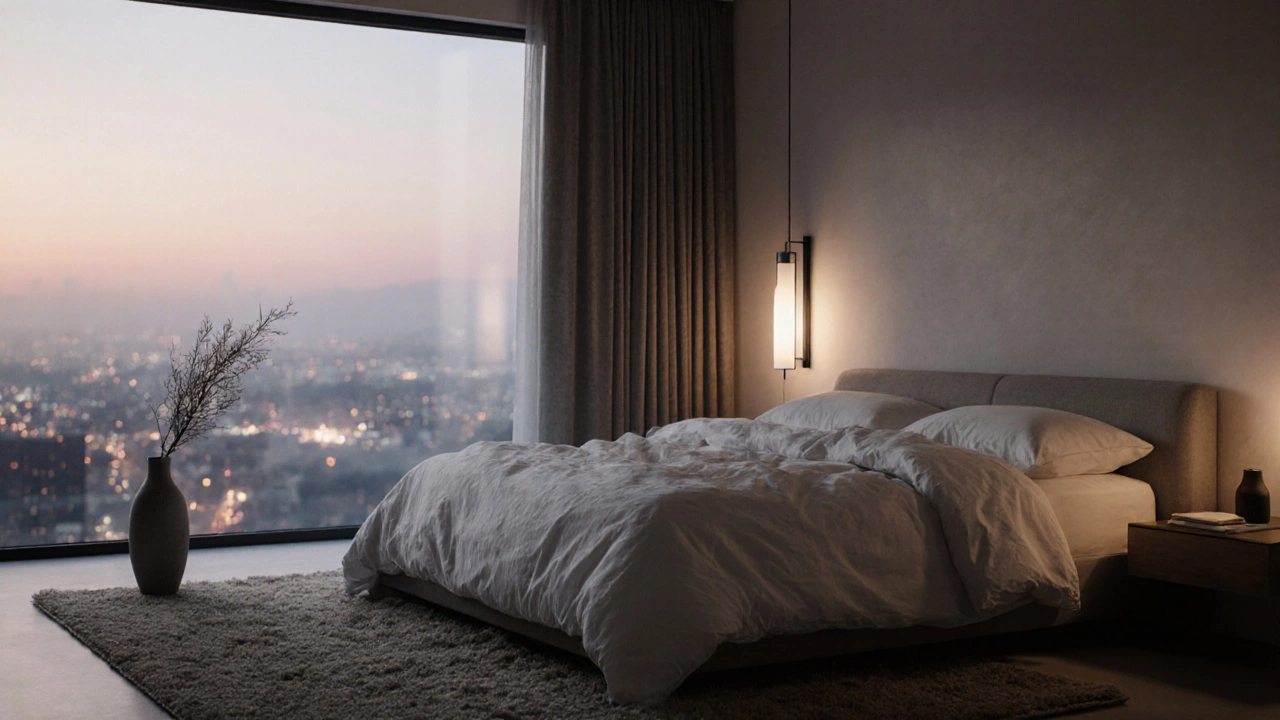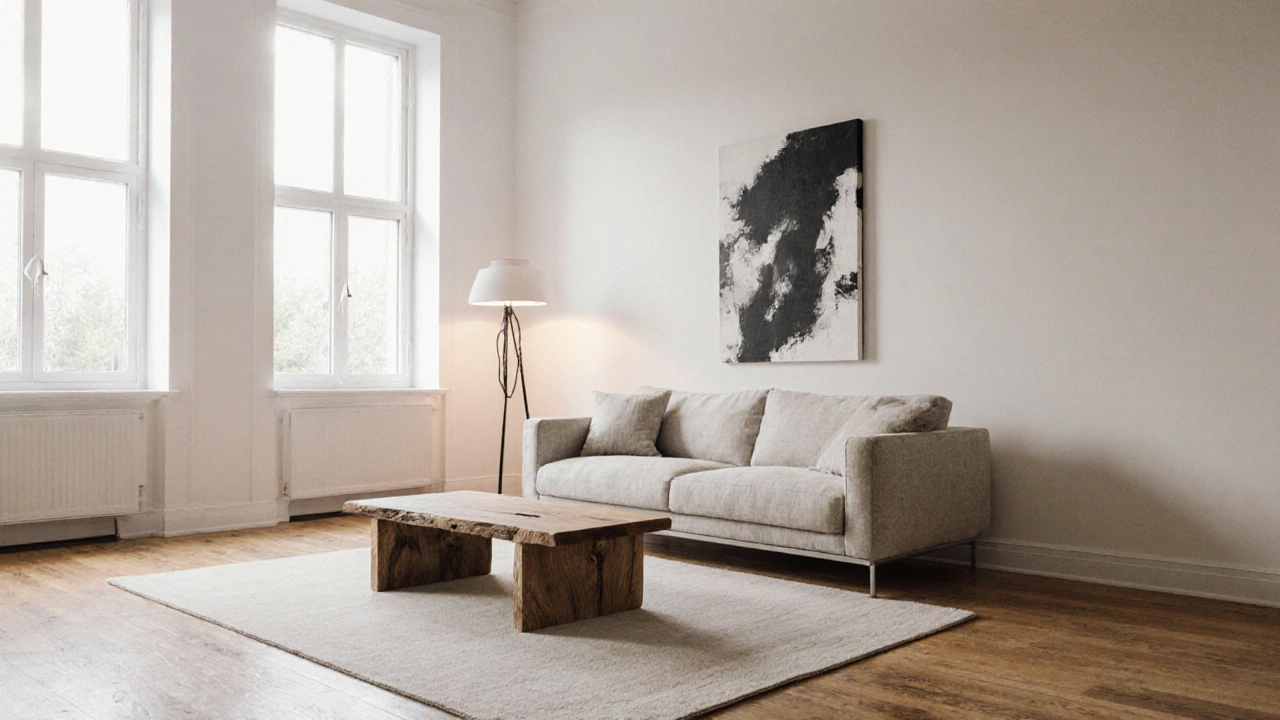Modern Color Palette Generator
Create a professional modern interior color palette with neutral bases and complementary accent colors. Perfect for walls, furniture, and decor.
Modern interior style isn’t just about sleek furniture and gray walls. It’s a mindset-one that values function over flash, space over clutter, and honesty in materials. If you’ve walked into a home that feels calm, open, and intentionally simple, you’ve experienced modern design. It doesn’t shout. It breathes. And it’s been reshaping homes since the early 20th century, not as a trend, but as a lasting approach to living.
What Defines Modern Interior Style?
Modern interior style emerged between the 1920s and 1950s, rooted in movements like Bauhaus and De Stijl. It rejected ornate details in favor of clean geometry, open layouts, and industrial materials. Today, it’s still defined by five core principles: simplicity, functionality, natural light, neutral palettes, and honest materials.
Unlike contemporary design-which shifts with current trends-modern design is timeless. A 1930s modern chair still looks at home in a 2025 living room. That’s because modern style doesn’t chase novelty. It seeks balance.
Think of it this way: modern interiors are like a well-tailored suit. No unnecessary pockets. No loud patterns. Just perfect fit and quiet confidence.
Key Elements of Modern Interior Design
- Flat, clean lines-No crown molding, no curved arches. Walls meet floors at sharp angles. Furniture has straight edges and minimal carving.
- Open floor plans-Kitchens flow into dining areas, living rooms connect to balconies. Walls are removed to create one continuous space.
- Neutral color schemes-White, beige, charcoal, and soft gray dominate. Accents come from texture, not paint. A single mustard armchair or a black metal lamp adds contrast without noise.
- Natural materials-Wood (oak, walnut, teak), concrete, steel, and glass are used raw or lightly finished. You see the grain. You feel the texture. You don’t hide it under veneer.
- Strategic lighting-Recessed ceiling lights, floor lamps with clean silhouettes, and hidden LED strips replace chandeliers. Light is layered, not decorative.
- Minimal decor-One large piece of art. One sculptural vase. Zero knick-knacks. Every object has a reason to be there.
Modern interiors avoid symmetry for the sake of symmetry. Instead, they use asymmetry to create visual rhythm. A sofa might sit off-center, balanced by a tall plant and a floor lamp on the opposite side. It feels intentional, not random.
Materials That Make Modern Style Work
Modern design doesn’t pretend. It shows what things are made of.
Wood is often left with a matte oil finish, not glossy varnish. Oak floors are wide-plank and lightly stained-never painted white. Concrete floors are polished, not covered with rugs. Steel frames hold glass doors without bulky trim. Even the light switches are flush-mounted, not raised plastic knobs.
One common mistake? Using fake materials. Laminate that looks like wood. Vinyl that mimics stone. Modern style rejects that. If you’re using wood, make sure it’s real. If you’re using metal, let it have its natural patina. A brushed steel faucet will age gracefully. A chrome-plated one will look cheap in five years.
Textiles matter too. Linen curtains. Wool rugs. Cotton throws. Synthetic fibers feel cold and artificial. They don’t breathe. They don’t age well. Modern interiors value materials that improve with time.

How to Avoid Common Modern Design Mistakes
Modern doesn’t mean empty. It doesn’t mean cold. But people often take it too far.
Mistake 1: Going too sterile. White walls, white furniture, white floors. The result? A hospital waiting room. Modern design uses texture to add warmth. A nubby wool rug. A rough-hewn wooden coffee table. A leather sofa with visible stitching. These add soul.
Mistake 2: Overdoing minimalism. Removing every book, every plant, every photo. That’s not minimalism. That’s deprivation. Modern style allows for personal expression-but with restraint. One shelf of carefully chosen books. One wall with a single large black-and-white photograph. That’s enough.
Mistake 3: Ignoring scale. Tiny sofas in huge rooms. Oversized art in small spaces. Modern design relies on proportion. A large sectional in a 15-foot living room? Perfect. A tiny armchair in the same space? It disappears. Measure twice. Choose once.
Mistake 4: Forgetting lighting layers. Relying only on ceiling lights makes a room feel flat. Add floor lamps, table lamps, and hidden LED strips. Light should come from multiple directions, not just one.
Modern Style in Different Rooms
Modern design works everywhere-but each room has its own rules.
Living room: Focus on a central seating arrangement. One large sofa, two side chairs, a low coffee table. No TV stand. Mount the TV on the wall. Keep side tables slim. Use a single statement piece-a sculptural floor lamp or a ceramic vase.
Kitchen: Flat-panel cabinetry, no handles (push-to-open mechanisms), integrated appliances. Countertops are quartz or solid surface, not marble (too busy). Under-cabinet lighting is essential. A single island with bar stools replaces a dining table.
Bedroom: Low-profile bed frame. No headboard or a thin, upholstered one. Bedding is neutral linen. Nightstands are simple cubes. No bedside lamps with shades-use wall sconces or slim floor lamps. The goal is sleep, not display.
Bathroom: Wall-mounted vanity. Frameless glass shower. Single sink. No clutter on counters. Towels folded neatly on a wooden shelf. Heated floors are common. Lighting is soft and indirect.
Modern vs. Contemporary: What’s the Difference?
People mix these up all the time. Here’s the clearest way to tell them apart:
| Feature | Modern | Contemporary |
|---|---|---|
| Time Period | 1920s-1950s | Current (changes yearly) |
| Color Palette | Neutral, earthy tones | Varies-can include bold colors |
| Lines | Sharp, geometric | Can be curved or fluid |
| Materials | Wood, steel, glass, concrete | Any material, including plastic, acrylic, velvet |
| Decor | Minimal, intentional | Can be eclectic, layered |
| Style Stability | Timeless | Trend-driven |
Modern is a fixed style. Contemporary is whatever’s popular right now. If your home looks like it came from a 2024 magazine, it’s probably contemporary. If it looks like it could’ve been designed in 1948 and still feel fresh, it’s modern.

How to Start Building a Modern Interior
You don’t need to rip out your whole house. Start small.
- Declutter ruthlessly. Remove anything that doesn’t serve a purpose or bring you joy. Keep only what you use daily.
- Paint walls white or warm gray. Sherwin-Williams Agreeable Gray or Benjamin Moore White Dove are safe, timeless choices.
- Replace lighting fixtures. Swap out ornate chandeliers for recessed LEDs or a single geometric pendant.
- Invest in one key piece. A mid-century modern armchair. A solid oak dining table. A concrete side table. Let this be your anchor.
- Use natural textiles. Swap polyester curtains for linen. Replace synthetic rugs with wool or jute.
- Keep surfaces clear. No magazines on the coffee table. No trinkets on the mantel. One object per surface, max.
Modern design isn’t about buying new things. It’s about removing the noise. It’s about making space-for light, for quiet, for living.
Why Modern Style Endures
It’s 2025. We’re overwhelmed. We’re tired of cluttered feeds, packed schedules, and noisy homes. Modern interiors offer a reset. They don’t demand attention. They invite calm.
Studies from the University of London show that people in minimalist, well-lit spaces report lower stress levels and better focus. That’s not coincidence. It’s design.
Modern style works because it’s human-centered. It doesn’t try to impress guests. It helps you feel at ease. It lets you breathe.
That’s why, decades after it began, modern interior style isn’t fading. It’s becoming the default for people who want their homes to feel like rest, not performance.
Is modern interior style the same as Scandinavian design?
No. Modern and Scandinavian share clean lines and minimalism, but Scandinavian design is warmer and cozier. It uses lighter woods, more textiles, and softer lighting. Modern style is more industrial-concrete, steel, and darker tones. Scandinavian is about hygge. Modern is about clarity.
Can modern style work in a small apartment?
Yes, it’s ideal. Modern design thrives in small spaces because it emphasizes openness and reduces visual clutter. Use light colors, mirror surfaces, and multi-functional furniture-like a sofa bed or a storage ottoman. Keep walls clear and lighting layered to make the space feel larger.
Do I need to buy expensive furniture for a modern look?
No. Many modern pieces are mass-produced and affordable. Look for clean silhouettes in wood, metal, or molded plastic. IKEA, Muji, and Article offer excellent budget-friendly options. Focus on quality materials and simple shapes-not brand names.
What colors should I avoid in modern interiors?
Avoid overly bright or clashing colors-neon greens, hot pinks, or busy patterns. Also skip heavy dark woods like mahogany or ornate gold finishes. Modern style prefers muted tones and natural material tones. If you want color, use it sparingly: one accent wall, one piece of art, or one cushion.
Can I mix modern with other styles?
Yes, but carefully. Modern works well with industrial (exposed pipes, metal) or Japandi (Japanese-Scandinavian fusion). Avoid mixing with traditional styles like Victorian or Baroque-they compete for attention. If you blend, let modern be the base. Add one vintage piece, not five.
Next Steps to Get Started
Start tomorrow. Clear one surface in your home-your coffee table, your kitchen counter, your nightstand. Remove everything that doesn’t belong. Then, add back only one thing you truly love: a ceramic bowl, a single book, a small plant.
That’s modern design in action. Not a renovation. Not a budget. Just a shift in how you see space.
